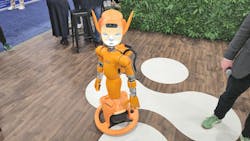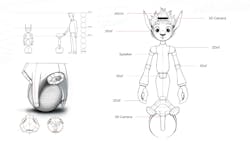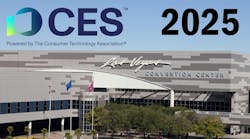Enchanting Robot Rolls About with an Animated Face
What you’ll learn:
- Why the Mirokaï robot is unique.
- Where Mirokaï might be used.
- About Mirokaï’s facial interaction.
Enchanted Tools improved its Mirokaï with a more robust platform (watch the video above). The robot is balanced atop a ball with a protected cage, enabling it to move in any direction (Fig. 1).
This user-friendly cobot is designed to operate in close proximity to people. Applications include tasks such as being a store assistant or concierge interacting with people verbally.
Mirokaï stands about 115 cm (Fig. 2). It has 28 degrees of freedom (DoF) incorporating two color/infrared cameras, a dozen time-of-flight (ToF) cameras, six ultrasound range sensors, and three inertial measurement units (IMUs). One IMU is in each hand along with one for the body. There’s also a six-axis torque sensor.
The robot’s battery lasts about eight hours. Mirokaï doesn’t use a lot of energy when standing still, and the cage around the ball lets it remain upright if power is lost. It weighs about 30 kg and has a maximum speed of 3.2 km/h. The two NVIDIA Jetson modules work with the Robot Operating System (ROS) running Enchanted Tools software.
The articulated arms and hands with opposable thumbs allow for the robot to manipulate objects. The hand is designed to work with handles with a solid grip. These handles can be attached to useful items such as trays or boxes so that Mirokaï can manipulate and transport these items with a high level of confidence.
Putting a Face on Robotics
Mirokaï’s face is a projection system. It enables the software to easily adjust what someone sees, although things like eyes are just images. This approach provides a flexible interface that’s easy to adjust via software with minimal power requirements. Image data acquisition is done using a 3D camera mounted above the faceplate. Audio output is via a speaker mounted in the chest.
The ears are movable and provide an additional visual feedback mechanism. This is more in line with the cobot’s operation in user interface applications, where it’s trying to be friendly and supportive.
The platform is programmable at the system level, but an “If This Then That” programming interface is designed for those without programming expertise. It can be used to create an engaging interaction with people taking advantage of the underlying artificial-intelligence (AI) support.
>>Check out more of our CES 2025 coverage
About the Author
William G. Wong
Senior Content Director - Electronic Design and Microwaves & RF
I am Editor of Electronic Design focusing on embedded, software, and systems. As Senior Content Director, I also manage Microwaves & RF and I work with a great team of editors to provide engineers, programmers, developers and technical managers with interesting and useful articles and videos on a regular basis. Check out our free newsletters to see the latest content.
You can send press releases for new products for possible coverage on the website. I am also interested in receiving contributed articles for publishing on our website. Use our template and send to me along with a signed release form.
Check out my blog, AltEmbedded on Electronic Design, as well as his latest articles on this site that are listed below.
You can visit my social media via these links:
- AltEmbedded on Electronic Design
- Bill Wong on Facebook
- @AltEmbedded on Twitter
- Bill Wong on LinkedIn
I earned a Bachelor of Electrical Engineering at the Georgia Institute of Technology and a Masters in Computer Science from Rutgers University. I still do a bit of programming using everything from C and C++ to Rust and Ada/SPARK. I do a bit of PHP programming for Drupal websites. I have posted a few Drupal modules.
I still get a hand on software and electronic hardware. Some of this can be found on our Kit Close-Up video series. You can also see me on many of our TechXchange Talk videos. I am interested in a range of projects from robotics to artificial intelligence.




